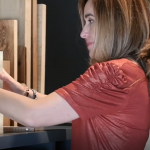Do you want to know more about CLT or cross laminated wood?
Cross-laminated lumber (CLT) is a solid structural lumber product manufactured with a minimum of three joined layers of right-angle laminated lumber and is designed for ceiling, floor and wall applications. CLT is pre-fabricated and digitally engineered with minimal production waste, improving efficiency, safety, and speed in construction.
What are the benefits of CLT?
CLT is one of the most efficient and safe forms of construction and also environmentally sustainable. Reduction of carbon emissions, reduction of the carbon footprint through production and high thermal efficiency.
It is a very light material, weighs 20% of the weight of concrete, and reduces foundation loads and distribution requirements. It also reduces labor costs because less labor is required to build the CLT system, and construction is faster – up to 30% faster than traditional construction methods. The CLT can be easily modified during and after construction.
The quality of the construction material has the equivalent level of durability as concrete. High precision manufacturing results in a high quality finish.
Is warping and shrinkage of wood a problem in CLT buildings?
No. CLT’s perpendicular cross laminate provides a dimensionally stable product, which avoids any significant deformation or shrinkage in the panel. This is the main difference between solid wood paneling and traditional timber framing systems.
Does it creak and move like a wood frame house, a CLT building?
No. The performance of a CLT building is more a reflection of a conventional concrete rather than a half-timbered house. All buildings experience movements caused by many factors, all of which in the long and short term can be controlled through design.
How does the CLT behave acoustically?
The acoustic performance of cross laminated wood is excellent and is equivalent to other construction methods. The solid cross section of CLT makes it possible to achieve very good acoustic performance for both ceilings and walls. As with other forms of construction, CLT does not rely entirely on the base material to provide the necessary acoustic performance.
Can CLT be exposed for architectural reasons?
Yes, CLT can be designed as an exposed component of a building, either internally or externally if it is protected from direct wetness or UV exposure.
How is condensation achieved in a building with cross laminated wood (CLT)?
In the same way as a conventional building by incorporating adequate moisture barriers and insulation.
How does a CLT building behave under seismic loads?
The CLT has a high strength-to-weight ratio that is ideal for seismic behavior. A well-designed wooden building works much better on seismic movement than a concrete building. A CLT structure is very safe, and it is also relatively easy and quick to repair possible damage after an earthquake, which is a great benefit for building owners. Performance is highly dependent on connections. Pallars Fustes has extensive experience in everything related to CLT and its applications.
Where does the wood used to make CLT come from? Is it sustainable?
CLT wood comes from sustainably managed forests in Australia or New Zealand. Sustainable forests are managed in such a way as to ensure that trees are planted to replace the trees that are harvested. And so they enter a replanting cycle as if it were a longer term harvest.
Does the carbon generated by the transportation and shipping of CLT still make the process sustainable?
Even when factoring in the impact of transportation and shipping, construction is still equivalent to half the carbon that a concrete building generates.
What is the useful life of the CLT building?
The Building Research Establishment in the UK has certified the CLT product for a lifespan of 60 years and there are occupied wooden buildings in Europe that are over 700 years old. The key factor in the longevity of a wooden structure is moisture management during the design stage.
What is the history of CLT?
The initial development of cross laminated timber (CLT) occurred in the early 1990s in Switzerland. In 1996, Austria carried out a joint research effort that resulted in the CLT product known today. In the early 2000s, the use of CLT in construction increased significantly and it is now a common construction method in Austria, Germany, Switzerland, Sweden, Norway, and the United Kingdom. North America is also beginning to use CLT as a form of construction.




